The Toronto Island ferries connect mainland Toronto, Ontario, Canada to Toronto Islands1 in Lake Ontario.
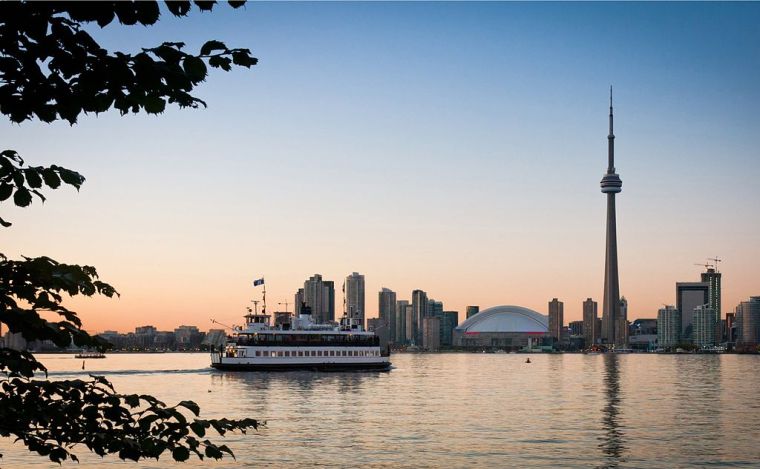 Photo source: Benson Kua from Toronto, Canada, In Transit Uploaded by tm, CC BY-SA 2.0, created 10 October 2008, https://en.wikipedia.org/wiki/Toronto_Islands#/media/File:In_Transit_(6307827132).jpg
Photo source: Benson Kua from Toronto, Canada, In Transit Uploaded by tm, CC BY-SA 2.0, created 10 October 2008, https://en.wikipedia.org/wiki/Toronto_Islands#/media/File:In_Transit_(6307827132).jpg
They carry passengers from the Jack Layton Ferry Terminal2, located between Bay Street and Yonge Street on Queens Quay, to several docks on the islands.
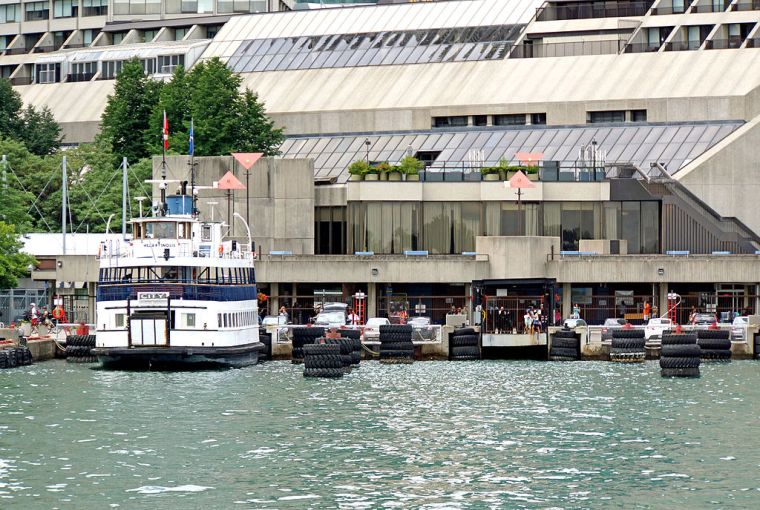 Jack Layton Ferry Terminal – Photo source: Dennis Jarvis from Halifax, Canada – Ontario-00656, CC BY-SA 2.0, created 17 July 2014, https://en.wikipedia.org/wiki/Jack_Layton_Ferry_Terminal#/media/File:ONTARIO-00656_-_Ferry_Docks_(14840339411).jpg
Jack Layton Ferry Terminal – Photo source: Dennis Jarvis from Halifax, Canada – Ontario-00656, CC BY-SA 2.0, created 17 July 2014, https://en.wikipedia.org/wiki/Jack_Layton_Ferry_Terminal#/media/File:ONTARIO-00656_-_Ferry_Docks_(14840339411).jpg
The ferry system records 75,000 passengers daily, with 4 lines, 8 vessels, and 6 terminals. There are an estimated 1.2 million passengers per year, mostly in the summer months. The information was obtained from the Wikipedia page “Jack Layton Ferry Terminal.”3 (insert pic)
The Toronto Ferry Docks are located at the foot of Bay Street and Queens Quay, just west of the Westin Harbour Castle Hotel. The address is 9 Queens Quay West, although the physical address is not labelled.4
See map here: https://www.torontoisland.com/map.php
Now, you might ask, Tita S, how do I get to the Toronto Ferry Docks? You can use your car and park around the ferry terminal, and it will cost you about CAD20-30 for the day on weekends. But considering the traffic, and the fact that the parking lots get full quickly, it might take you some time before you find a vacant spot. So, why not take the subway or GO train to Union Station? It is a 10-minute walk south from the ferry docks at the foot of Bay Street. You can also take the Streetcar one stop from Union Station to the Island Ferry Docks. The docks are also served by the Bay St. bus. Get off the Queen’s Quay stop.5
Majority of the tourists who go to Toronto Islands1 ride ferry boats, operated by the City of Toronto, although some opt to use water taxis6. See related posts: TORONTO ISLANDS FERRY TICKETS AND ISLAND DOCKS and NOW YOU KNOW: THE TORONTO WATER TAXIS
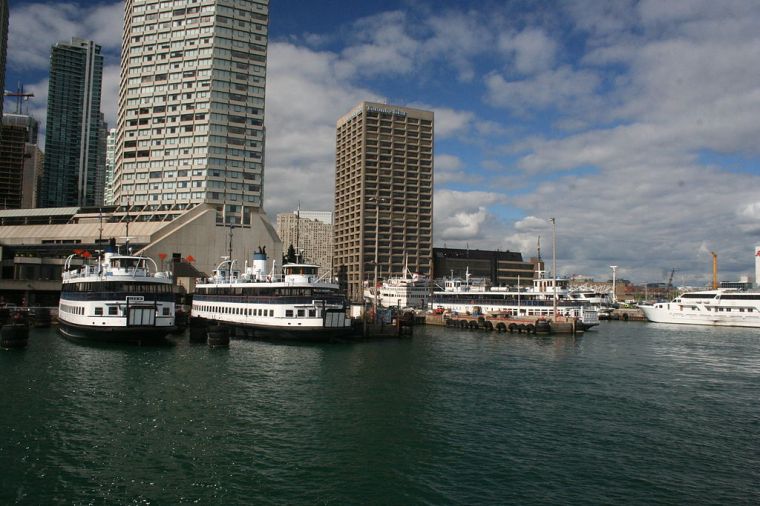 Jack Layton Ferry Terminal (featuring l-r: Ferry Thomas Rennie, Ferry Sam McBride, Jadran, Trillium) – Photo source: Robert Taylor from Stirling, Canada – Ferry Terminal, Toronto Ontario_3390, CC BY-SA 2.0, created 15 September 2010, https://en.wikipedia.org/wiki/Toronto_Island_ferries#/media/File:The_Thomas_Rennie,_Sam_McBride,_Jadran,_Trillium_at_the_ferry_terminal_in_Toronto.jpg
Jack Layton Ferry Terminal (featuring l-r: Ferry Thomas Rennie, Ferry Sam McBride, Jadran, Trillium) – Photo source: Robert Taylor from Stirling, Canada – Ferry Terminal, Toronto Ontario_3390, CC BY-SA 2.0, created 15 September 2010, https://en.wikipedia.org/wiki/Toronto_Island_ferries#/media/File:The_Thomas_Rennie,_Sam_McBride,_Jadran,_Trillium_at_the_ferry_terminal_in_Toronto.jpg
ACTIVE VESSELS OF TORONTO ISLAND FERRIES
Here is a brief description of the 9 active vessels of Toronto Island ferries:
1. David Hornell, formerly TCCA1, was built by HMP, acquired in 2006, and operated by Toronto Port Authority (TPA)/PortsToronto (PT) to the island airport. Its original name was an acronym of Toronto City Centre Airport 1, and was renamed in honor of Toronto-born RCAF pilot and World War II ace Flt-Lt. David Hornell (1910-1944).
2. Maple City was built by Muir Brothers Dock Yard in 1951 for Prescott-Ogdensburg ferry service, acquired in 1964 as a ferry for Toronto Islands1, operated by TPA/PT, and can accommodate 40 passengers and 6 cars.
3. Marilyn Bell 1, formerly TCCA2, was built by HMP, acquired in 2009, operated by TPA/PT to the island airport. Its original name was an acronym of Toronto City Centre Airport 2, and was renamed in honor of Toronto-born long-distance swimmer Marilyn Bell (born 1937).
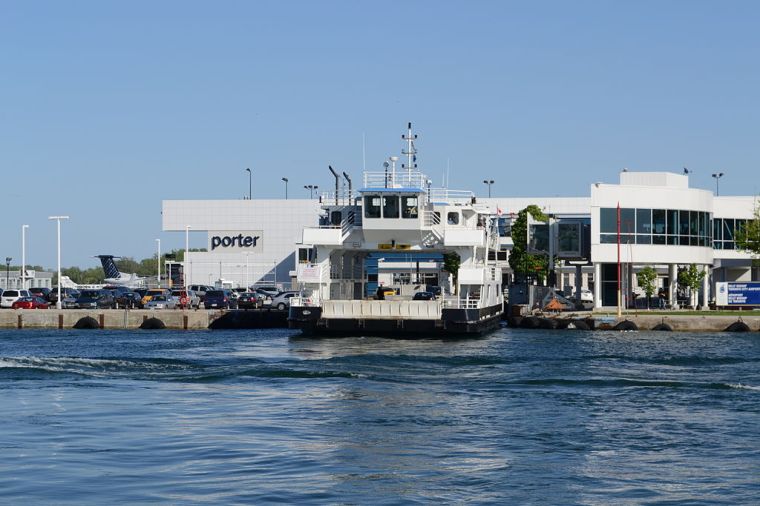 Ferry Marilyn Bell 1 docked at the Island Airport docks – Photo source: Raysonho @ Open Grid Scheduler / Grid Engine, Own work, CC0, created 2 June 2011, https://en.wikipedia.org/wiki/Toronto_Island_ferries#/media/File:MarilynBell-I3.jpg
Ferry Marilyn Bell 1 docked at the Island Airport docks – Photo source: Raysonho @ Open Grid Scheduler / Grid Engine, Own work, CC0, created 2 June 2011, https://en.wikipedia.org/wiki/Toronto_Island_ferries#/media/File:MarilynBell-I3.jpg
Watch this video: https://www.youtube.com/watch?v=Nn-0Vaghz60
4. Ongiara is the vessel which operates to the island airport. It was built by RB, acquired in 1963, operated by Toronto Transit Commission (TTC)7, MPC and TPR, and can accommodate 220 passengers, 10 cars or 8 trucks. It used to provide winter service and to carry service vehicles. It was re-powered in November 2006.
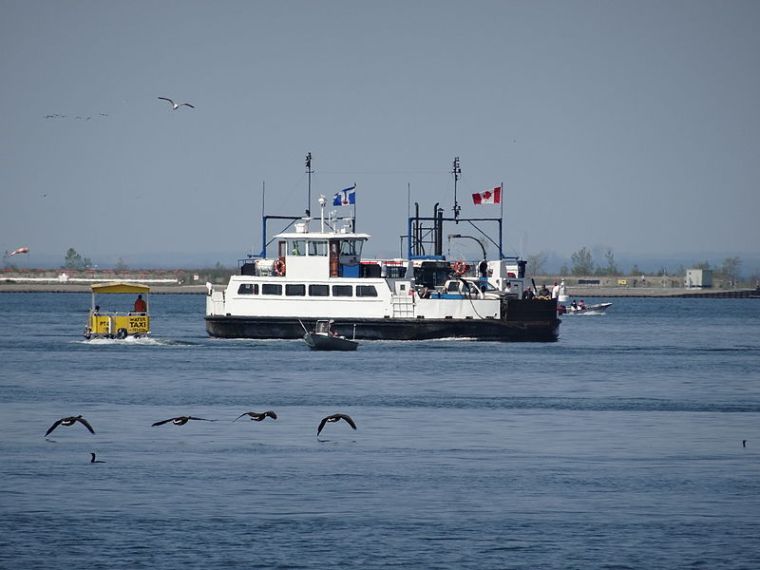 Ferry Ongiara (and Water Taxi) – Photo source: booledozer – Ferries in Toronto’s harbour, 2015 05 28 (3), Public Domain, created 28 May 2015, https://en.wikipedia.org/wiki/Ongiara_(ferry)#/media/File:Ferry_Ongiara_in_Toronto’s_harbour,_2015_05_28_(17587409623).jpg
Ferry Ongiara (and Water Taxi) – Photo source: booledozer – Ferries in Toronto’s harbour, 2015 05 28 (3), Public Domain, created 28 May 2015, https://en.wikipedia.org/wiki/Ongiara_(ferry)#/media/File:Ferry_Ongiara_in_Toronto’s_harbour,_2015_05_28_(17587409623).jpg
5. Sam McBride was built by TDC & JIC, acquired in 1939, operated by TTC7, MPC and TPR, and could accommodate 1,000 passengers, but reduced to 524, and then to 736 due to upgrades to bulkhead and engines in 2011, just like Thomas Rennie. It was named after former Toronto mayor and alderman8 Sam McBride (1866 – 1936).
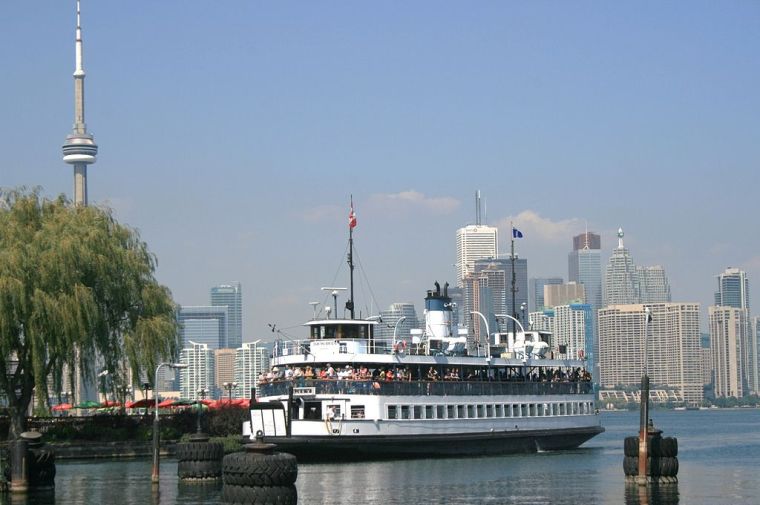 Ferry Sam McBride – Picture source: Robert101 – Toronto Ferry Uploaded by Skeezix 1000, CC BY 2.0, created 3 September 2009, https://en.wikipedia.org/wiki/Toronto_Islands#/media/File:Toronto_ferry.jpg
Ferry Sam McBride – Picture source: Robert101 – Toronto Ferry Uploaded by Skeezix 1000, CC BY 2.0, created 3 September 2009, https://en.wikipedia.org/wiki/Toronto_Islands#/media/File:Toronto_ferry.jpg
6. Thomas Rennie was built by TDC & JIC, acquired in 1951, operated by TTC7, MPC and TPR, and could accommodate 1,000 passengers, but reduced to 524, and then to 736 due to upgrades to bulkhead and engines in 2011, just like Sam McBride. It is named after former Toronto Harbour Commissioner Thomas Rennie.
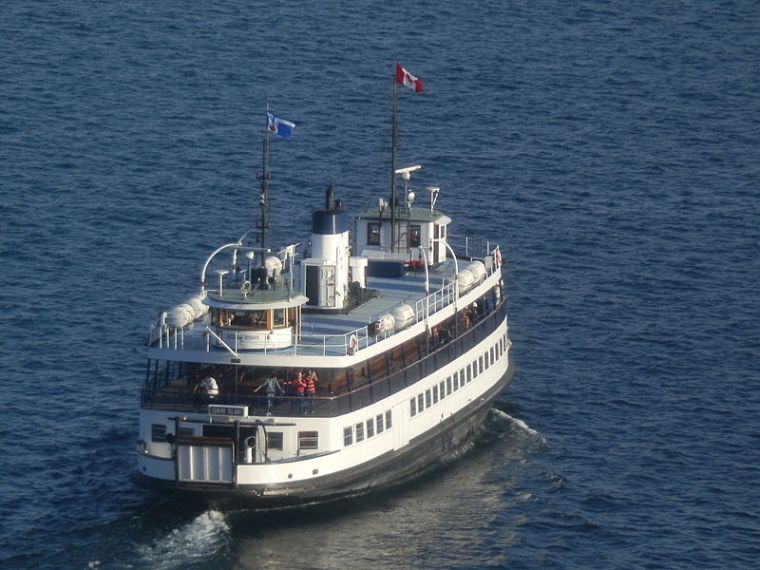 Ferry Thomas Rennie – Photo source: Ibagli – Own work, CC0, created 21 May 2012, https://en.wikipedia.org/wiki/Thomas_Rennie_(ferry,_1951)#/media/File:Toronto_ferry_Thomas_Rennie.JPG
Ferry Thomas Rennie – Photo source: Ibagli – Own work, CC0, created 21 May 2012, https://en.wikipedia.org/wiki/Thomas_Rennie_(ferry,_1951)#/media/File:Toronto_ferry_Thomas_Rennie.JPG
7. Trillium was built by Portland Iron Works (PIW), acquired in 1910, currently operated by TFC, TTC7, MPC and TPR, and could accommodate 800 passengers. It was retired in 1957, stored next to the Island Water Filtration Plant, but re-entered service in 1976, after being refurbished.
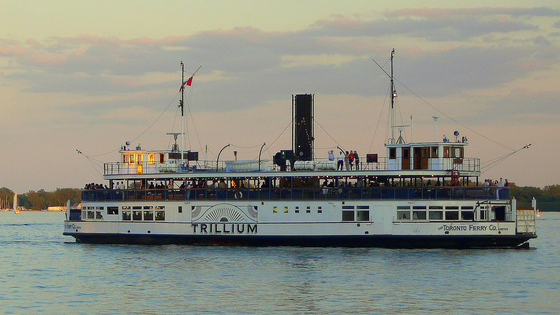
Trillium – Photo source: Andy Burgess – File: Toronto Harbour Trillium.jpg, CC BY 2.0, created 24 March 2012, https://en.wikipedia.org/wiki/PS_Trillium#/media/File:Trillium_clip_wide.jpg
8. William Inglis was built by TDC & JIC, acquired in 1935, operated by TTC7, MPC and TPR, and can accommodate 400 passengers. It was originally launched as the Shamrock, but was renamed after the death of William Inglis, head of local appliance manufacturer, John Inglis and Sons.
 Ferry William Inglis – Photo source: booledozer – Ferry William Inglis, 2015 05 16, Public Domain, created 16 May 2015, https://en.wikipedia.org/wiki/William_Inglis_(ferry)#/media/File:Ferry_William_Inglis,_2015_05_16_(17571086788).jpg
Ferry William Inglis – Photo source: booledozer – Ferry William Inglis, 2015 05 16, Public Domain, created 16 May 2015, https://en.wikipedia.org/wiki/William_Inglis_(ferry)#/media/File:Ferry_William_Inglis,_2015_05_16_(17571086788).jpg
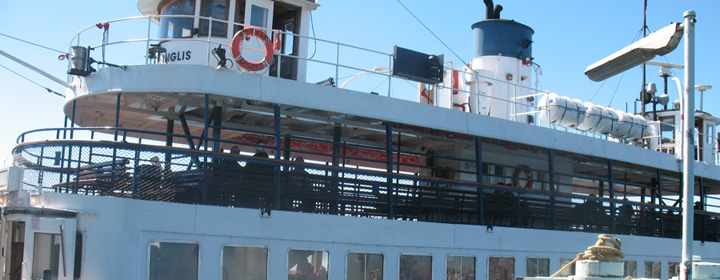 Picture source: https://www.torontoisland.com/ferry.php
Picture source: https://www.torontoisland.com/ferry.php
9. Windmill Point was built by KS, acquired in 1954, operated by TPA/PT, and can accommodate 207 passengers. It is based in Amherstburg, Ontario and operates to the island airport when Maple City, another vessel (see above) is out of service. It was purchased by the Toronto Harbour Commission in 1985 and stored at Keating Channel when not in service.
 Ferry Windmill Point in the Keating Channel – Photo source: Geo Swan (talk), own work, created 7 May 2009, https://en.wikipedia.org/wiki/File:Ferry_Windmill_Point,_in_the_Keating_Channel_-a.jpg
Ferry Windmill Point in the Keating Channel – Photo source: Geo Swan (talk), own work, created 7 May 2009, https://en.wikipedia.org/wiki/File:Ferry_Windmill_Point,_in_the_Keating_Channel_-a.jpg
CHRONOLOGY
Of course, before she ends her post, Tita S needs to give you a chronology of Toronto Island Ferries:
1833 – Ferry services to the Islands began. The boat named Sir John of the Peninsula was the first ferry to cross Toronto Harbour. It was a 4-horse boat, operated by Michael O’Connor, between York and his hotel on the island (then still a peninsula), known as the Retreat on the Peninsula. At that time, persons could still access the peninsula from a road to the east of York, crossing over the Don.
1835 – The first steam-powered ferry to the said hotel was inaugurated, but was eventually removed from service and sold. The hotel came under new management. Sir John of the Peninsula was reinstated.
1836 – The City of Toronto established a toll gate on the road, charging sixpence for every 4-wheeled carriage drawn by 2 horses, and other tolls for smaller carriages, wagons or riders.
1843 – A converted steamboat, the Peninsula Packet, propelled by paddle wheels driven by horses, was pressed into service for the Retreat on the Peninsula. It remained in operation until 1850.
1853 – The Retreat on the Peninsula came under the management of John Quinn who introduced another steam ferry, the Victoria.
1854 – Robert Moodie introduced his own steam ferry, the Bob Moodie. Quinn added the Welland, another steam ferry.
1857 – Moodie added the Lady Head steam vessel.
1858 – A storm hit the island on April 13 and destroyed the Retreat on the Peninsula Hotel as well as Parkinson’s Hotel, and created a 500-yard- (460 m) wide eastern gap, making the previous peninsula an island.
Years later – The popularity of the island increased. There were 47 ferries operating in the harbor, with most being paddle steamers operated by individual owners.
1882 – The Turner Ferry Company was founded. It eventually competed with A. J. Tymon’s Island Ferry Company.
The SESD-paddle steamer-vessel Luella was acquired. It was built by WAC and JDE, and can accommodate 122 passengers. It was operated by the TuF, TFC and TTC until 1934, when it was accidentally scrapped.
Three other vessels were purchased: Canadian, Prouvette Beyer, (both operated by TuF and TFC) and Sadie (operated by TuF). I saw no record what happened to them thereafter, except that they are no longer active.
1890 – The vessel Mayflower was acquired
1892 – The assets of the Turner Ferry Company were bought by the John Doty Engine & Ferry Company, which in turn, merged with A. J. Tymon’s Island Ferry Company to form the Toronto Ferry Company.
1906 and 1910 – The Toronto Ferry Company built 2 double-decked, double-ended paddle steamers, with a capacity of 1,450 passengers, named Bluebell and Trillium. The company continued to operate the ferry services until 1926. The original terminal of the Toronto Island Ferry Docks, now called the Jack Layton Ferry Terminal2, was located on the east side of the Toronto Harbour Commission Building at Bay and Harbour Streets.
1907 – The original terminal was destroyed by fire and was rebuilt. A steamship terminal and berth areas were added to the east side. The site is now filled in and occupied by a parking lot.
After 1918 – When the infilling of the harbor took place, the docks moved to Queens Quay West, between Yonge Street and Bay Street, now the site of the Harbour Square condos, before being moved to the west, to the current location. It had a waiting room, and was heated in the wintertime. This second terminal would be there until the redevelopment of the Toronto waterfront would begin in 1972.
1926 – The City of Toronto purchased the services and fleet of the Toronto Ferry Company for CAD337,500. You see, the company was in arrears on rent to the City to the amount of CAD6,500, and only operated with the assurance that the City would buy the boats at the end of the season. The ferry service ran a deficit of CAD647.
1927 – In February, the City transferred the 8-boat fleet to the Toronto Transportation Commission (TTC, later renamed the Toronto Transit Commission), the body that operates the city’s transit system. Three boats included in the purchase – the John Hanlan, the Jasmine, and the Clark Bros, were found to be in poor condition, and all ended up being burned for amusement at Sunnyside Amusement Park, in Toronto, Ontario.
1934 – The SESD-paddle steamer-vessel Luella was accidentally scrapped and retired.
1935 – The William Inglis, the first of the 3 double-ended, diesel-engined and screw-driven ferries, was built for TTC.
Between 1935 and 1938 – The ferries carried 2 million passengers per year.
1938 – The Toronto Harbour Commission began operating a ferry service to the new Toronto Island Airport, then under construction. A scow9 was adapted for use as a cable ferry10, with the intention that this ferry would operate only for a five-year period, but actually remained in service for 25 years, before being replaced by the ferry Maple City.
1939 – The Sam McBride, the second of 3 double-ended, diesel-engined and screw-driven ferries, was built for TTC.
World War II – Visitors going to Toronto Islands declined.
1951 – The Thomas Rennie, the third of 3 double-ended, diesel-engined and screw-driven ferries, was built for TTC.
1954 – The ferry service ran a deficit of CAD500,000, considered a scandalous waste of money.
1955 – Bluebell, a double-decked, double-ended paddle steamer of the Toronto Ferry Company was retired.
1957 – Trillium, a double-decked, double-ended paddle steamer of the Toronto Ferry Company was retired, but survived.
1960 – The number of visitors to Toronto Islands started to increase.
1962 – In January 1, the ferry services operated by the TTC were transferred to Metro Toronto Parks and Culture, a department of the then municipality of Metropolitan Toronto.
The two-180hp diesel engine vessel, Shiawassie, built by Gormley, was acquired by the Parks Department for CAD41,000, and operated by TPA/PT till 1977. It could accommodate 68 passengers.
1966 – Parks Commissioner Tommy Thompson suggested buying hovercrafts to replace the ferries, but failed to gain political interest. Other possibilities that were floated were a vehicle tunnel, a bridge over the Eastern Gap, and a monorail.
Visitors going to Toronto Islands reached 1 million.
1970 – The ferries carried 1.42 million passengers to the Islands. This declined in subsequent years, attributed to the introduction of other attractions in Toronto.
1972 – The third terminal of the Toronto Island Ferry Docks opened in January, shifted about 100 meters to the east of the second location (see after 1918 above). The new terminal was part of a planned CAD85 million waterfront project in 1964, and completed at a cost of CAD250 million, that would see the Bay Street shipping slip filled in, and Harbour Castle Hilton and Harbour Square condos built. The cost of the new terminal was CAD519,000. It had no waiting room as the ferries stopped operating during winter time.
1976 – Trillium, a double-decked, double-ended paddle steamer of the Toronto Ferry Company, re-entered service. It is operated by the Great Lakes Schooner Company for corporate and private functions, and for ferry runs during summer.
1977 – The two-180hp diesel engine vessel, Shiawassie, was retired and sold.
1985 – The backup ferry Windmill Point was acquired.
1995 – The ferries carried 1.21 million passengers to the Islands, with an average summer day carrying 25,000 passengers, and an average winter day carrying 500 passengers. The annual budget to operate the ferries was CAD4.5 million, of which ticket revenues covered CAD4 million.
1997 – Metro Toronto and the Metro municipalities were amalgamated into Toronto, and the park ferry services became the responsibility of the City of Toronto’s Department of Parks and Recreation, today, the Parks, Forestry and Recreation Division.
2006 – A new replacement ferry, TCCA1, was acquired. The Port Authority subsequently purchased another ferry, the Marilyn Bell 1.
2012 – The Toronto City Council unanimously voted to rename Island Ferry Docks to Jack Layton Ferry Terminal2, in honor of late New Democratic Party leader, former Toronto City councilor, and federal Member of Parliament, Jack Layton.
Safety standards have been updated over the years, and the ferries were allowed to continue to operate under a “grandfather” clause11. This year, Thomas Rennie, Sam McBride, and William Inglish engines and bulkheads were updated. The modernization meant that they were no longer “grandfathered” and were then in contravention. The ferries’ passenger capacity was reduced, and Transport Canada agreed to restore the ferries’ “grandfather” status.
In October, the Toronto City Council decided that funds should be set aside to replace three above-mentioned ferries, with new vessels.
2013 – On the second anniversary of Jack Layton’s death, the Island Ferry Docks was renamed Jack Layton Ferry Terminal2. A bronze statue of Layton riding on a tandem bicycle was installed at the site.
2015 – The Toronto Port Authority (TPA) changed its name to PortsToronto, responsible for the management of the harbor of Toronto, Ontario, Canada, the Billy Bishop Toronto City Airport, Billy and Bishop Toronto City water Aerodrome.
2017 – The Islands were flooded and placed the Centre Island Docks out of commission, causing Centreville Amusement Park to remain closed for the season.
2019 – The Centre Island Docks was rebuilt for the 2019 season to accommodate higher lake levels. This year’s flooding did not close the dock.
The information was obtained from the Wikipedia page “Toronto Island ferries”.12
Photo sources of cover picture-collage (l-r): Jack Layton Ferry Terminal (featuring l-r: Ferry Thomas Rennie, Ferry Sam McBride, Jadran, Trillium) – Photo source: Robert Taylor from Stirling, Canada – Ferry Terminal, Toronto Ontario_3390, CC BY-SA 2.0, created 15 September 2010, https://en.wikipedia.org/wiki/Toronto_Island_ferries#/media/File:The_Thomas_Rennie,_Sam_McBride,_Jadran,_Trillium_at_the_ferry_terminal_in_Toronto.jpg; Benson Kua from Toronto, Canada, In Transit Uploaded by tm, CC BY-SA 2.0, created 10 October 2008, https://en.wikipedia.org/wiki/Toronto_Islands#/media/File:In_Transit_(6307827132).jpg
Did you find this post informative? I would like to hear from you re your experience riding the Toronto Island ferries going to Toronto Islands and the use of the island docks, not only during summertime but other seasons. Simply scroll and click “Leave a comment”. Do share this post with your Facebook friends, follow me by clicking on the bottom right corner of your device, and do not forget to like this post. Thank you.
– – – – – – – – – – – – – – – – – – – – – – – – – –
The following terms are defined for interested readers, especially those with “Senior-Moments”, not familiar with Toronto, and those too busy or lazy to Google such terms:
1Toronto Islands, also called the Island or Toronto Island Park, is a chain of 15 small islands at a total area of 332 ha., in the western part of Lake Ontario, about 1.6 km south of downtown Toronto, Ontario, Canada. The islands are located just offshore from the city’s downtown, a 10-15-minute ferry ride from the Jack Layton Ferry Terminal2 at the foot of Bay Street and Queen’s Quay. Access to the Islands can also be through water taxi or private yacht. The information was obtained from the Wikipedia page “Toronto Islands.”13
2The Jack Layton Ferry Terminal, formerly called the Toronto Island Ferry Docks, is the ferry slip14 for Toronto Island ferries operated by the City of Toronto Parks, Forestry and Recreation Division. The terminal is located at located at 9 Queens Quay West, the foot of Bay Street, in the Toronto Harbour, behind the Westin Harbour Castle Hotel, and adjacent to Harbour Square Park. It is south of Bay Street and Queens Quay in Toronto, Ontario, Canada. It consists of 4 piers. located in the enclosed main docks, and the last pier is an open area to the east for the larger Trillium ferry boat. During winter months, the ferries, other than Trillium, are stored here with upper decks covered with a tarp. Trillium is stored at nearby Yonge Street Slip. The information was obtained from the Wikipedia page “Jack Layton Ferry Terminal.”3
3“Jack Layton Ferry Terminal,” accessed August 6, 2018, https://en.wikipedia.org/wiki/Jack_Layton_Ferry_Terminal
5https://www.torontoisland.com/map.php
6A water taxi, water bus or sightseeing boat, is a watercraft used to provide public or private transport, usually, but not always, in an urban environment. Service may be scheduled with multiple stops (operating in a similar manner to a bus), or on demand to many locations (operating in a similar manner to a taxi). Taxi sizes vary from small boats carrying a few passengers to larger vessels carrying 10 or more passengers. The information was obtained from the Wikipedia page “Toronto water taxi.”15
7TTC stands for the Toronto Transit Commission, the public transport agency that operates bus, subway, streetcar, and paratransit16 services in Toronto, Ontario, Canada. It is the oldest and largest of the urban transit service providers in the Greater Toronto Area, with numerous connections to systems serving its surrounding municipalities. It also operated to Toronto Island ferry service from 1927 to 1962, when it was transferred to the Metro Parks and Culture department, now Toronto Parks, Forestry and Recreation.17
8Alderman, in Canada, was a term used for those persons elected to a municipal council to represent the wards. When women were increasingly elected to municipal office, the term councillor slowly replaced alderman, although some use the term alderperson. However, some smaller municipalities as well as Alberta and Ontario, retain the title for historical reasons. The information was obtained from the Wikipedia page “Alderman.”18
9A scow is a large flat-bottomed sailboat with broad, square, sloping ends, used to carry cargo in coastal waters and inland waterways, having the advantage when navigating shallow water or serving small harbors during the 19th and early 20th centuries. The information was obtained from the Wiktionary page “Scow.”19
10A cable ferry is a type of ferry which propels itself by means of one or more steel cables laid across a body of water. The information was obtained from the Wiktionary page “Cable Ferry.”20
11A grandfather clause is a provision in which an old rule continues to apply to some existing situations while a new rule will apply to all future cases. Those exempt from the new rule are said to have grandfather rights or acquired rights, or to have been grandfathered in. Frequently, the exemption is limited; it may extend fort a set time, or it may be lost under certain circumstances. Often, such a provision is used as a compromise or out of practicality, to allow new rules to be enacted without upsetting a well-established logistical or political situation. The information was obtained from the Wikipedia page “Grandfather Clause.”21
12“Toronto Island ferries,” accessed August 6, 2018, https://en.wikipedia.org/wiki/Toronto_Island_ferries
13“Toronto Islands,” accessed August 6, 2018, https://en.wikipedia.org/wiki/Toronto_ Islands
14A ferry slip is a specialized docking facility that receives a ferryboat, according to the Wikipedia page “Ferry slip.”22
15“Toronto water taxi,” accessed August 6, 2018, https://en.wikipedia.org/wiki/Toronto_water_taxi
16Paratransit is the term used in North America for transportation services that supplement fixed-route mass transit by providing individualized rides without fixed routes or timetables. Paratransit services may be operated by public transit agencies, community groups, not-for-profit organizations, and for-profit private companies or operators.23
17“Toronto Transit Commission,” accessed August 6, 2018, https://en.wikipedia.org/wiki/Toronto_Transit_Commission
18“Alderman,” accessed August 6, 2018, https://en.m.wikipedia.org/wiki/Alderman
19“Scow,” accessed August 6, 2018, https://en.wiktionary.org/wiki/scow
20“Cable ferry,” accessed August 6, 2018, https://en.wiktionary.org/wiki/cable_ferry
21“Grandfather clause,” accessed August 6, 2018, https://en.wikipedia.org/wiki/Grandfather_clause
22“Ferry slip,” accessed August 6, 2018, https://en.wikipedia.org/wiki/Ferry_slip
23“Paratransit,” accessed August 6, 2018, https://en.wikipedia.org/wiki/Paratransit


Good article!!
LikeLike
Thank you for appreciating.
LikeLike